Which is more likely to happen as a result of a sudden incre
Which is more likely to happen as a result of a sudden increase in aggregate demand?
Recession only.
Inflation only.
Stagflation.
Which is more likely to happen as a result of a sudden increase in aggregate supply?
Recession only.
Inflation only.
Stagflation.
None.
Let c=0.8. Then in our simple model of aggregate demand a dollar increase in taxes causes.
A 5 dollar increase in the equilibrium output.
A 5 dollar decrease in the equilibrium output.
A 4 dollar increase in the equilibrium output.
A 4 dollar decrease in the equilibrium output.
Let c=0.8. Then in our simple model of aggregate demand a dollar decrease in government expenditures causes
A 5 dollars increase in the equilibrium output.
A 5 dollar decrease in the equilibrium output.
A 4 dollar increase in the equilibrium output.
A 4 dollar decrease in the equilibrium output.
Which of the following is true?
The multipliers of the government expenditures and taxes are easily calculated by the government.
Fiscal policy is usually not successful because the government cannot control most economic variables.
Fiscal policy cannot fix the economy overnight because tax and spending policies affect aggregate demand after some time.
Consumer spending immediately reacts to income tax cuts.
Both b and c.
In 2009-2010 fiscal policy debates,
Republicans voted against the stimulus package because they believed that the economy can rely on its self-correcting mechanism.
Democrats offered to reduce taxes as a part of the stimulus package.
Republicans liked the stimulus package and the majority of them voted for it.
Which of the following is true?
A recessionary gap cannot be closed completely because of sticky wages.
Empirical studies show that a recessionary gap can be closed automatically and quickly.
Wages decrease dramatically in the time of recession for reasons such as minimum wages, union contacts, and government restrictions.
Firms do not tend to reduce wages by much during a recession because they are afraid of losing their best workers.
Both a and d.
Which of the following is true?
The multipliers of the government expenditures and taxes are easily calculated by the government.
Fiscal policy is usually successful because the government can control most economic variables.
Fiscal policy cannot fix the economy overnight because tax and spending policies affect aggregate demand after some time.
Consumer spending immediately reacts to income tax cuts.
Contractionary fiscal policy
is designed to increase aggregate demand.
Is designed to decrease aggregate demand.
Is designed to increase aggregate supply.
Is designed to decrease aggregate supply.
a, and c.
Expansionary fiscal policy
leads to an increase in a country’s output.
Leads to a reduction in a country’s output.
Increases the inventories below the desired level.
b and c.
a and c.
An inflationary gap can theoretically close on its own because.
Aggregate supply will gradually shift to the right as input prices decrease in the time of inflation.
Aggregate demand will gradually shift to the right as input prices decrease in the time of inflation.
Aggregate demand will gradually shift to the left as input prices increase in the time of inflation.
Aggregate supply will gradually shift to the left as input prices increase in the time of inflation.
None of the above.
Let c=0.8. Then
A 10 dollar increase in disposable income will increase consumption by 2 dollars.
A 10 dollar increase in disposable income will decrease consumption by 8 dollars.
A 10 dollar increase in disposable income will increase consumption by 8 dollars.
A 10 dollar decrease in disposable income will decrease consumption by 8 dollars.
c and d.
Let c=0.9. Then
A 10 dollar increase in disposable income will increase saving by 1 dollar.
A 10 dollar increase in disposable income will increase consumption by 9 dollars.
A 10 dollar increase in disposable income will increase consumption by 90 cents.
A 10 dollar decrease in disposable income will decrease consumption by 1 dollar.
a and b.
In the time of recession
The government deficit tends to increase as a result of expansionary fiscal policies.
The government deficit tends to decrease as a result of contractionary fiscal policies.
Increasing government expenditures is not appropriate.
It is appropriate to increase taxes.
d and c.
Which of the following is true?
The government expenditures multiplier increases as “c” increases.
Fiscal policy is successful only in recessions.
Fiscal policy fixes the economy quite rapidly because tax and spending policies affect aggregate demand instantly.
Consumer spending does not immediately react to income tax cuts.
Both a and d.
Which of the following is true?
A recessionary gap can be closed completely because of sticky wages.
Theoretically, an inflationary gap can eventually lead to stagflation.
Wages increase in the time of recession for reasons such as minimum wages, union contacts, and government restrictions.
a and b.
Which is more likely to happen as a result of a sudden reduction in aggregate demand?
Recession only.
Inflation only.
Stagflation.
None.
Which of the following is true?
In our simple model of aggregate demand the government expenditures multiplier is smaller than the tax multiplier.
The tax multiplier is negative suggesting that a reduction in taxes decreases our equilibrium output.
The tax multiplier is positive but smaller than the government expenditures multiplier.
None of the above.
Which is more likely to happen as a result of a sudden increase in aggregate demand?
Recession only.
Inflation only.
Stagflation.
Which is more likely to happen as a result of a sudden increase in aggregate supply?
Recession only.
Inflation only.
Stagflation.
None.
Let c=0.8. Then in our simple model of aggregate demand a dollar increase in taxes causes.
A 5 dollar increase in the equilibrium output.
A 5 dollar decrease in the equilibrium output.
A 4 dollar increase in the equilibrium output.
A 4 dollar decrease in the equilibrium output.
Let c=0.8. Then in our simple model of aggregate demand a dollar decrease in government expenditures causes
A 5 dollars increase in the equilibrium output.
A 5 dollar decrease in the equilibrium output.
A 4 dollar increase in the equilibrium output.
A 4 dollar decrease in the equilibrium output.
Which of the following is true?
The multipliers of the government expenditures and taxes are easily calculated by the government.
Fiscal policy is usually not successful because the government cannot control most economic variables.
Fiscal policy cannot fix the economy overnight because tax and spending policies affect aggregate demand after some time.
Consumer spending immediately reacts to income tax cuts.
Both b and c.
In 2009-2010 fiscal policy debates,
Republicans voted against the stimulus package because they believed that the economy can rely on its self-correcting mechanism.
Democrats offered to reduce taxes as a part of the stimulus package.
Republicans liked the stimulus package and the majority of them voted for it.
Which of the following is true?
A recessionary gap cannot be closed completely because of sticky wages.
Empirical studies show that a recessionary gap can be closed automatically and quickly.
Wages decrease dramatically in the time of recession for reasons such as minimum wages, union contacts, and government restrictions.
Firms do not tend to reduce wages by much during a recession because they are afraid of losing their best workers.
Both a and d.
Which of the following is true?
The multipliers of the government expenditures and taxes are easily calculated by the government.
Fiscal policy is usually successful because the government can control most economic variables.
Fiscal policy cannot fix the economy overnight because tax and spending policies affect aggregate demand after some time.
Consumer spending immediately reacts to income tax cuts.
Contractionary fiscal policy
is designed to increase aggregate demand.
Is designed to decrease aggregate demand.
Is designed to increase aggregate supply.
Is designed to decrease aggregate supply.
a, and c.
Expansionary fiscal policy
leads to an increase in a country’s output.
Leads to a reduction in a country’s output.
Increases the inventories below the desired level.
b and c.
a and c.
An inflationary gap can theoretically close on its own because.
Aggregate supply will gradually shift to the right as input prices decrease in the time of inflation.
Aggregate demand will gradually shift to the right as input prices decrease in the time of inflation.
Aggregate demand will gradually shift to the left as input prices increase in the time of inflation.
Aggregate supply will gradually shift to the left as input prices increase in the time of inflation.
None of the above.
Let c=0.8. Then
A 10 dollar increase in disposable income will increase consumption by 2 dollars.
A 10 dollar increase in disposable income will decrease consumption by 8 dollars.
A 10 dollar increase in disposable income will increase consumption by 8 dollars.
A 10 dollar decrease in disposable income will decrease consumption by 8 dollars.
c and d.
Let c=0.9. Then
A 10 dollar increase in disposable income will increase saving by 1 dollar.
A 10 dollar increase in disposable income will increase consumption by 9 dollars.
A 10 dollar increase in disposable income will increase consumption by 90 cents.
A 10 dollar decrease in disposable income will decrease consumption by 1 dollar.
a and b.
In the time of recession
The government deficit tends to increase as a result of expansionary fiscal policies.
The government deficit tends to decrease as a result of contractionary fiscal policies.
Increasing government expenditures is not appropriate.
It is appropriate to increase taxes.
d and c.
Which of the following is true?
The government expenditures multiplier increases as “c” increases.
Fiscal policy is successful only in recessions.
Fiscal policy fixes the economy quite rapidly because tax and spending policies affect aggregate demand instantly.
Consumer spending does not immediately react to income tax cuts.
Both a and d.
Which of the following is true?
A recessionary gap can be closed completely because of sticky wages.
Theoretically, an inflationary gap can eventually lead to stagflation.
Wages increase in the time of recession for reasons such as minimum wages, union contacts, and government restrictions.
a and b.
Which is more likely to happen as a result of a sudden reduction in aggregate demand?
Recession only.
Inflation only.
Stagflation.
None.
Which of the following is true?
In our simple model of aggregate demand the government expenditures multiplier is smaller than the tax multiplier.
The tax multiplier is negative suggesting that a reduction in taxes decreases our equilibrium output.
The tax multiplier is positive but smaller than the government expenditures multiplier.
None of the above.
Solution
1) A sudden increase in aggregate demand causes inflation to rise . The overall price level rises but there is a supply contstraint since supply cannot rise so suddenly . So there is no production growth but inflation occurs . Answer : stagflation .
2) A sudden increase in aggregate supply causes the price level to fall suddenly causing a recessio . Answer : recession .
3) dY / dT = - MPC / ( 1 - MPC )
MPC = C = 0.8
dT = 1 dollar
dY = - 0.8 / 0.2 = -4 . Answer : A 4 dollar decrease in the equilibrium output.
4) dY / dG = 1 / 1 - MPC
Here G falls by 1 dollar , so dG = -1
- dY = 1 / 0.2 = 5 . Hence , dY = -5 .
Answer : A 5 dollar decrease in the equilibrium output.
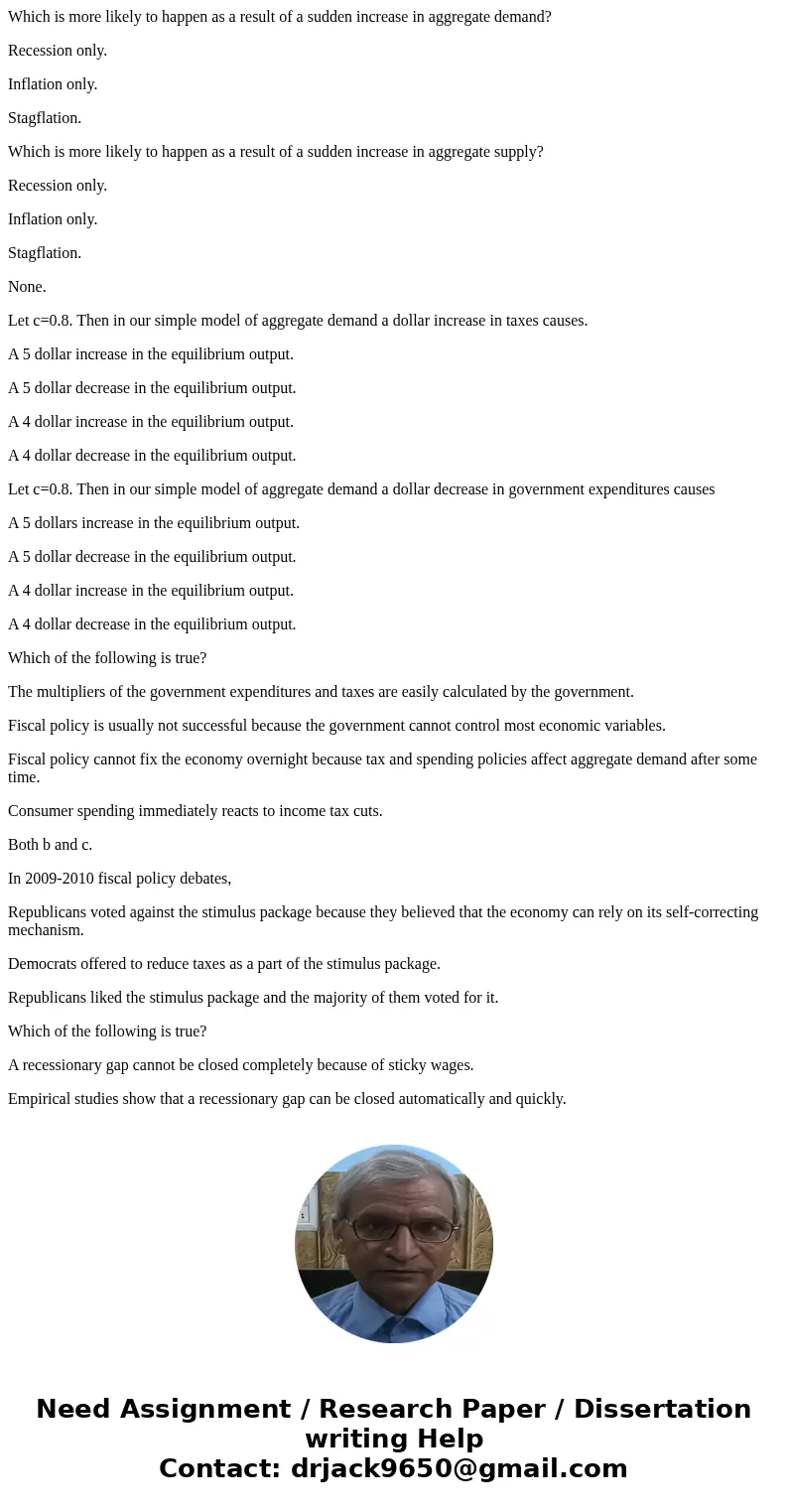
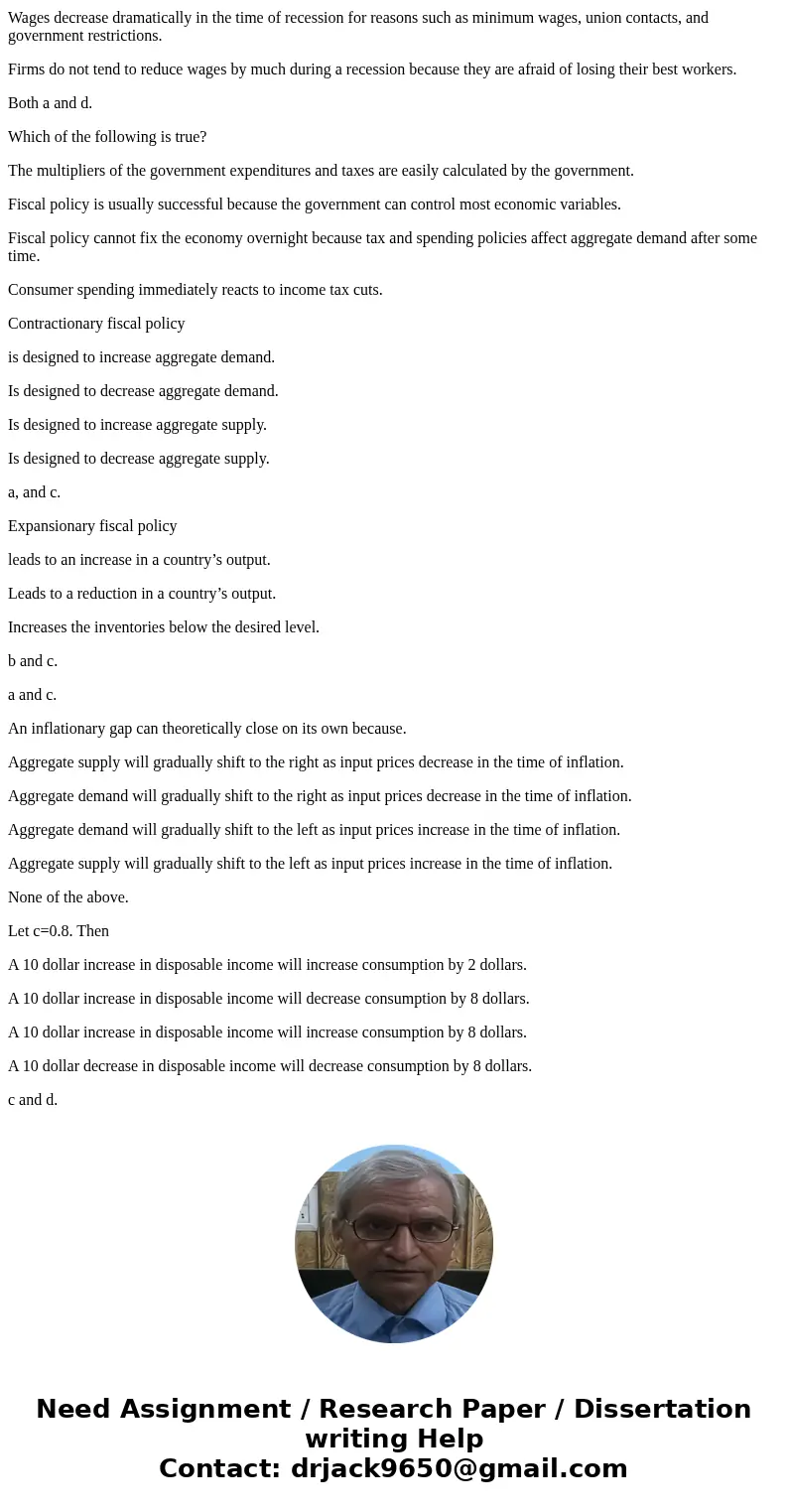
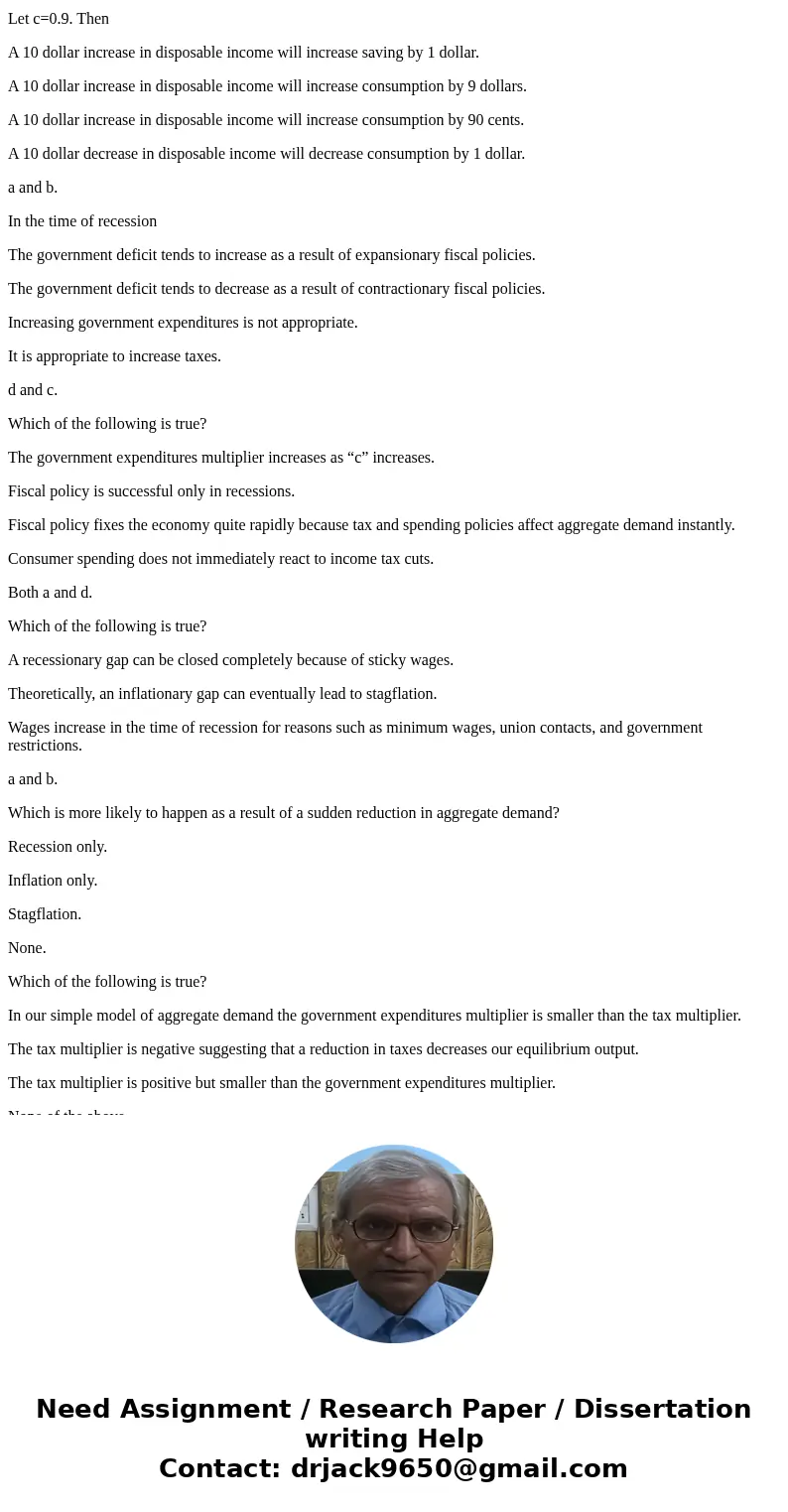
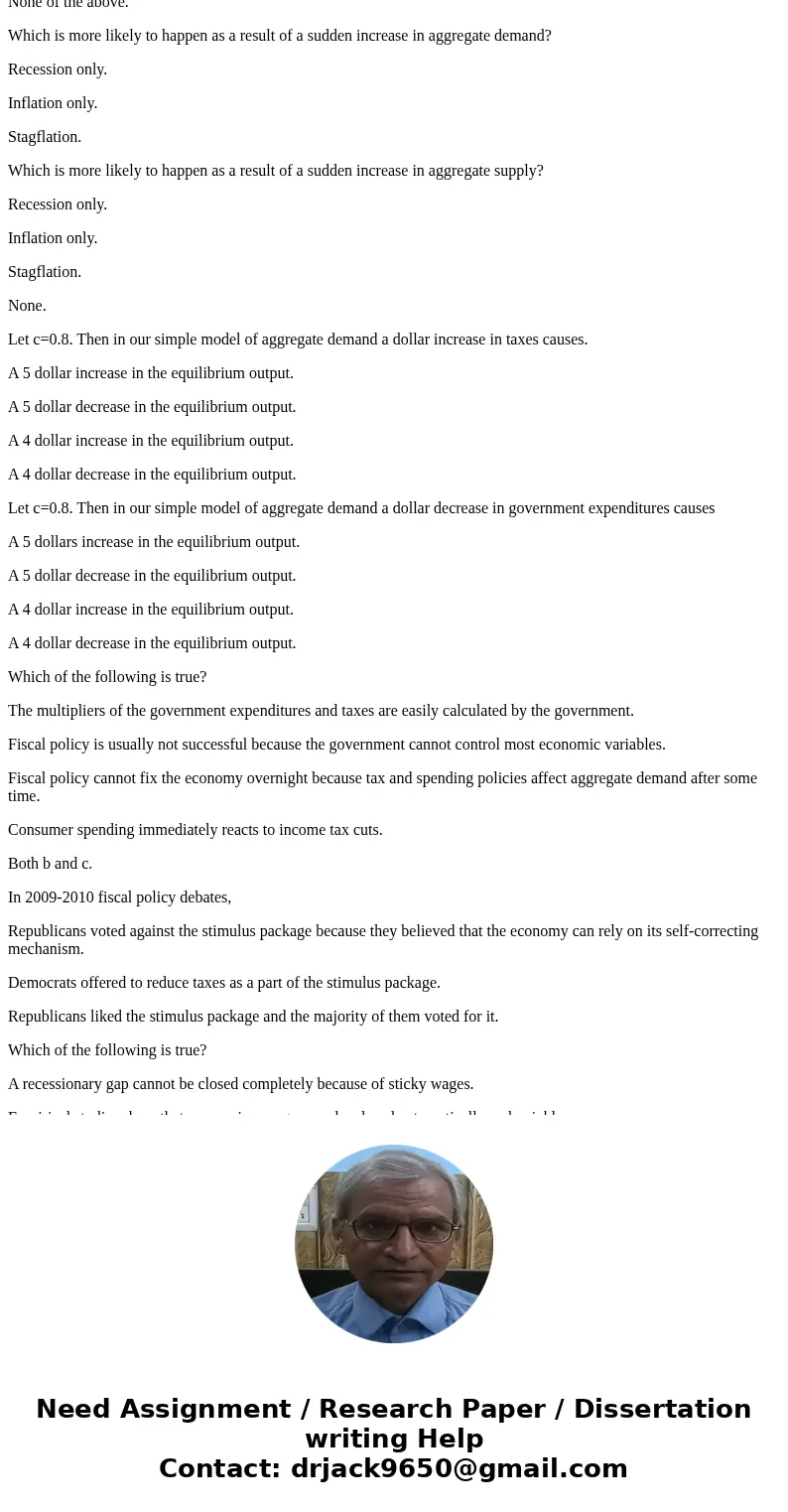
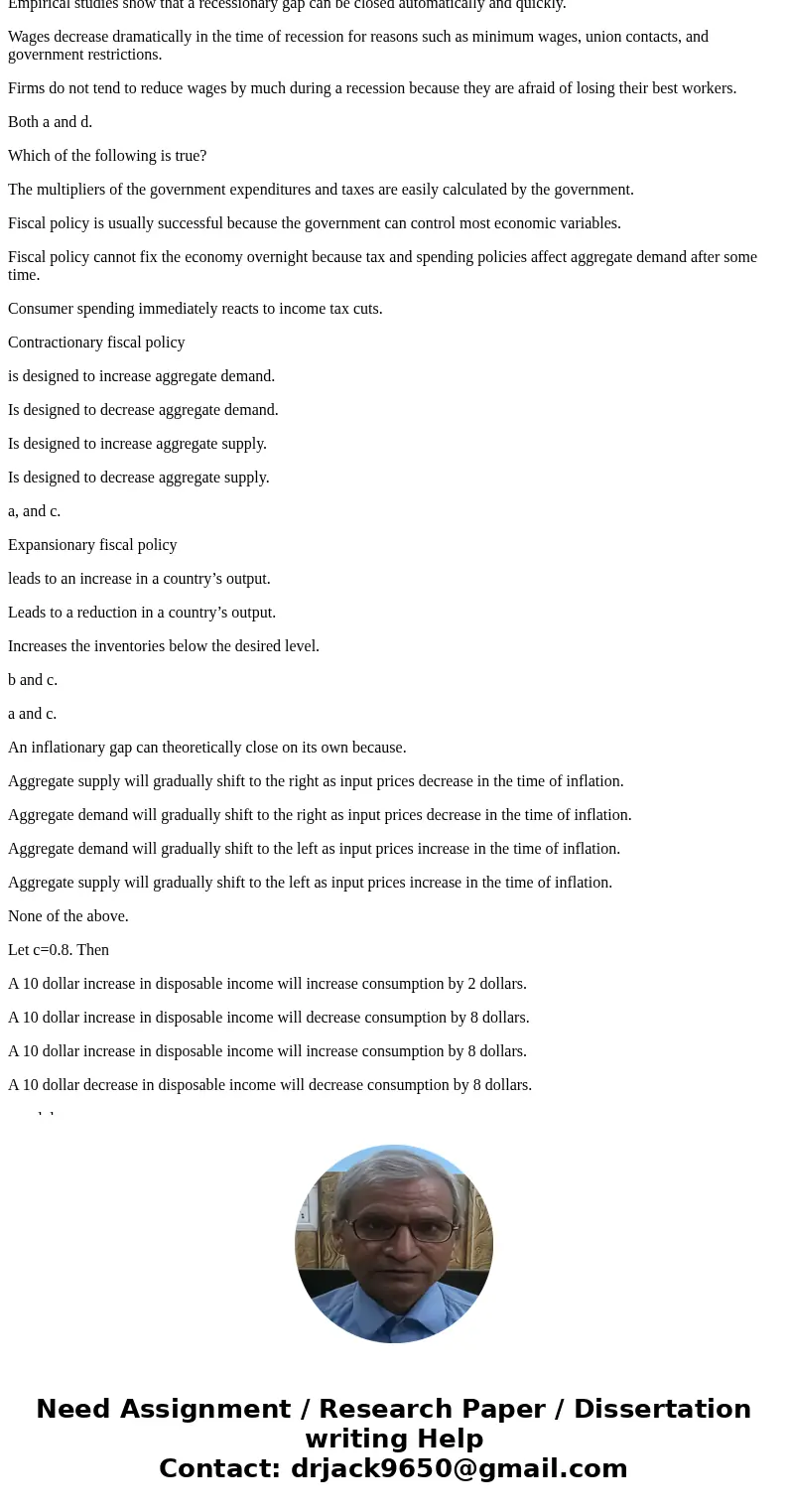
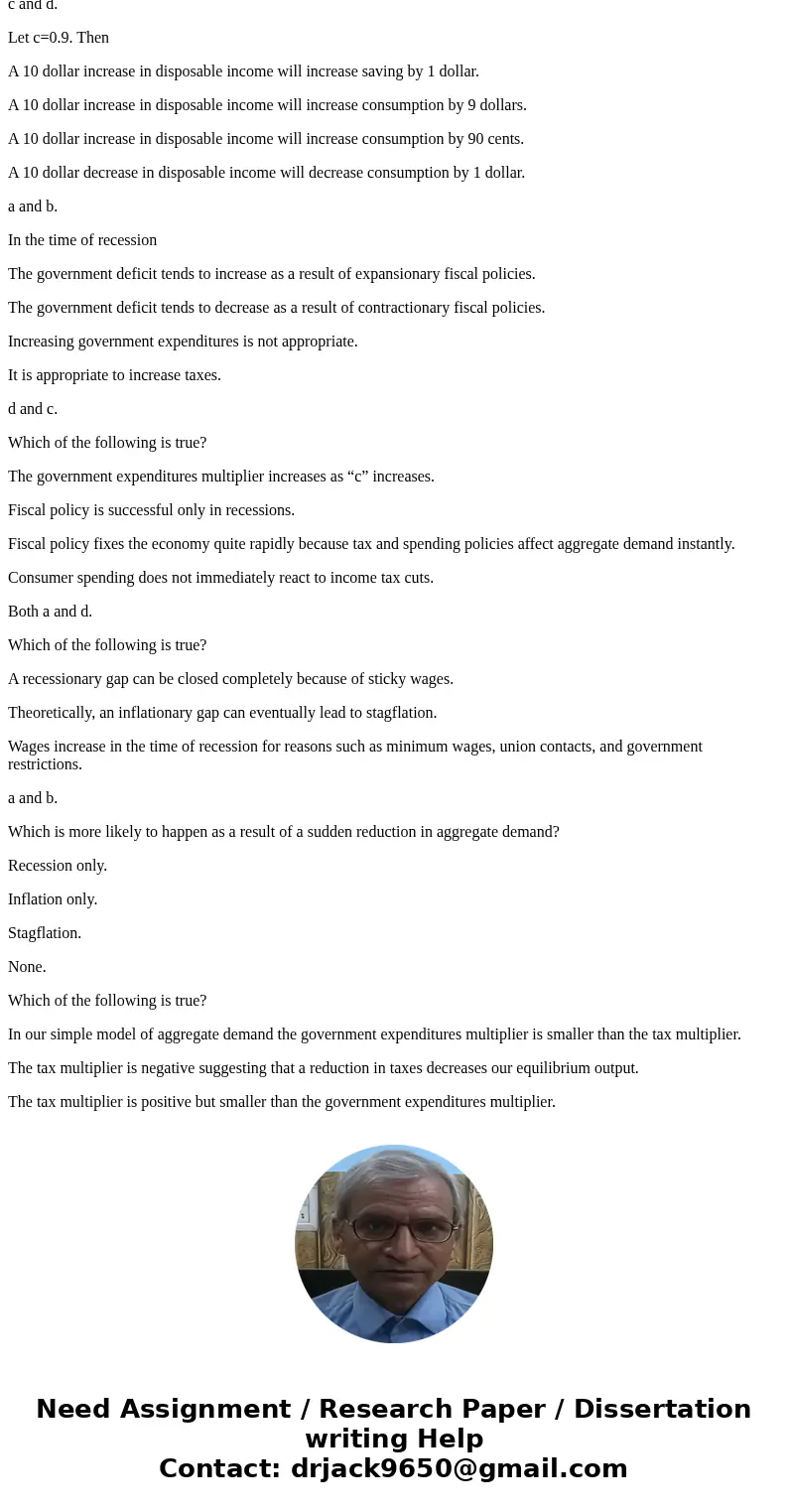
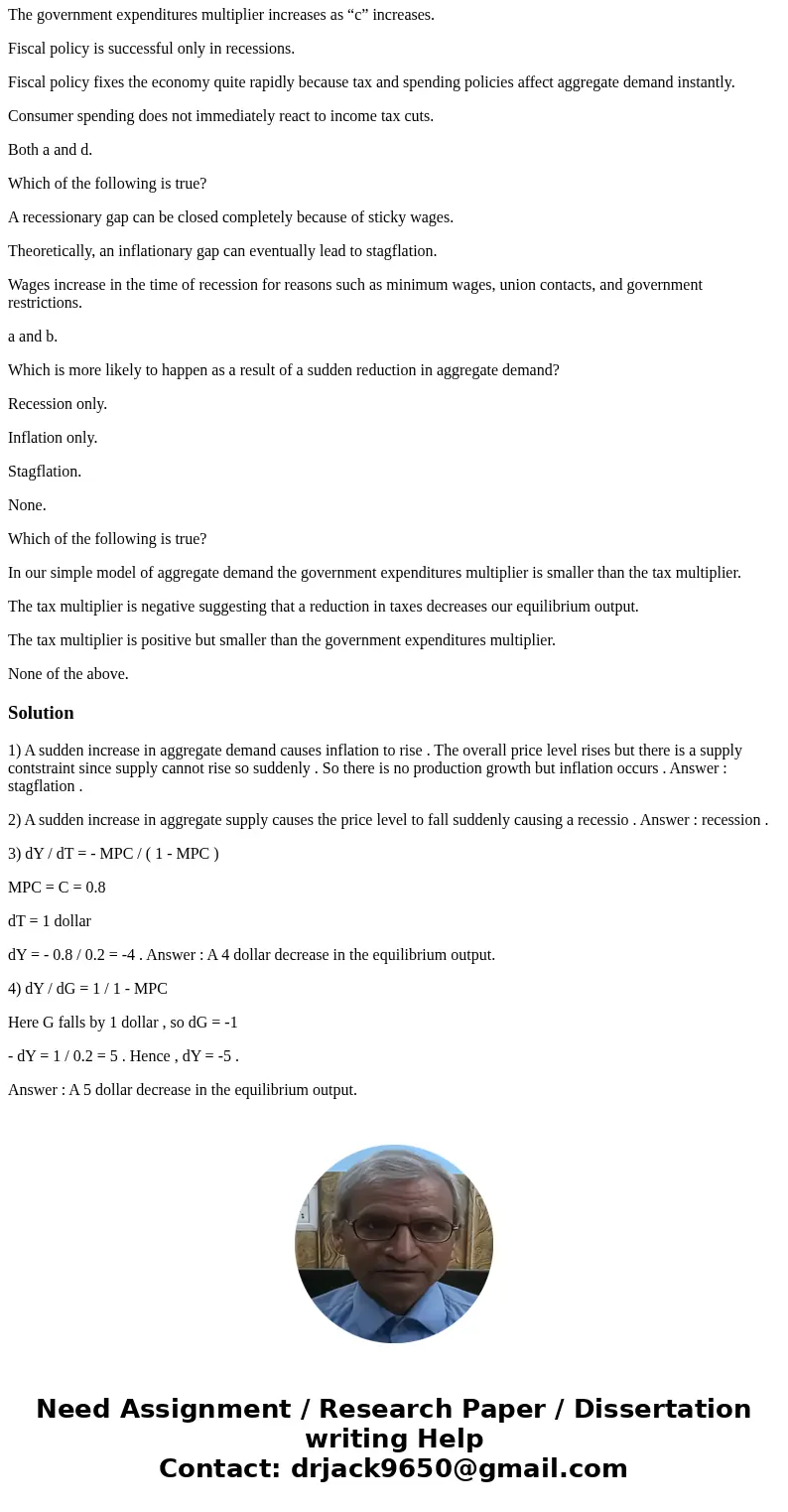
 Homework Sourse
Homework Sourse